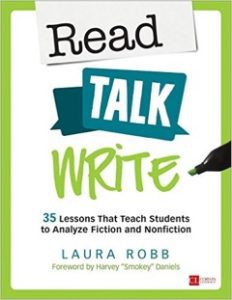Recently, I met with a group of teachers who brought their documented conferences to our after-school meeting. Fifth-grade teacher, Beverly Walters shared a conference she had with one of her fifth-grade students. The focus of the conference was to see how much the student recalled about the mini-lessons on finding the main idea. Beverly asked the student, “What do you remember about finding main ideas?”
“Nothing and I’m tired,” was the immediate response. It’s obvious that the student wanted to close any discussion of identifying main ideas. Instead of reacting negatively to that comment or taking it personally, Beverly went into the coaching mode. She presented a think aloud with a short text, modeled, and then invited the student to practice. The conference ended with all the positives Beverly noticed. Coaching students in reading is similar to coaching a sport.
Coaching and Sports
The word “coach” is usually associated with individual sports like tennis and team sports like basketball. The primary job of a sports coach is to provide practice and offer models to improve players’ technical skills, develop automaticity of moves and plays, and nurture an enjoyment of the sport. Coaches are critical to the success of their team or individual players. Coaching also involves attending to the emotions individuals feel during practice and competition. A coach’s ability to communicate to a team or individuals is key to their success. Like the sports coach, the teacher who wears the mantle of coach can improve students’ learning through practice and by meeting their emotional needs.
Coaching in a Reading Workshop
Workshop is ideal for coaching students. Each day, during workshop, students read silently and/or work on writing. Such independent work times allow you to have focused 5-minute, one-on-one coaching sessions. If students require more than five minutes, schedule a few consecutive sessions. Limiting coaching to five-minute time bursts means you can coach two to four students during a twenty-minute independent work time.
What Can You Coach?
Topics for coaching are everywhere. They emerge from your mini-lessons, from your observations of students working, from reading their written work, from their questions, level of participation, their behavior and comments, their self-evaluations, and reflections on their work. Let students lead the way; they will give you more coaching topics than you want. Responding to students’ needs sends the message that you care deeply about their progress and want to help them move to independence.
Coaching-On-The-Go
When students practice a mini-lesson, circulate among them to see how things are going. To coach-on-the-go, bend down next to the student, make eye contact, and support the student for two minutes max. Frequently, during that brief encounter, you can clarify a misunderstanding or review a process and prevent a small confusion from becoming an obstacle. If you need more time with a student, schedule a five-minute conference to explore what the student’s needs are.
Side-by-Side Coaching
During a scheduled coaching meeting always sit side-by-side the student because it puts teacher and student on an equal plane. It also allows you to observe the student at work, to make eye contact, and to think aloud and model in close proximity, allowing you to determine whether the student “gets it.” The messages you send by sitting side-by-side are you care, this time belongs to the student, and the practice is important. And all the time you’re building trust together—trust that gives a student the inner strength to risk making mistakes in order to understand and learn.
Self-Reflection and Coaching
Reflection allows you and a student to take a deep breath and think about the coaching session. Take an extra minute when a session ends to debrief together and discuss what was working, to create the agenda for the next coaching session, or to set a small goal. Invite students to self-reflect in their notebooks after three to four coaching sessions. Use questions to stimulate their thoughts: How did the coaching help you? What did you learn? Why can you work independently? Why are raising questions helpful and important? Why can you work on your own now?
Benefits of Coaching
Coaching builds a positive relationship between you and students you coach. It offers students opportunities to ask questions out of the “public eye of the rest of the class.” It’s personal and attends to students’ academic and emotional needs. The time you reserve for coaching is precious because it always holds out the potential to each student for deeper understanding of a topic, skill, strategy, or concept and moving to independence.
A great book by Laura! Read-Talk-Write

![]()













